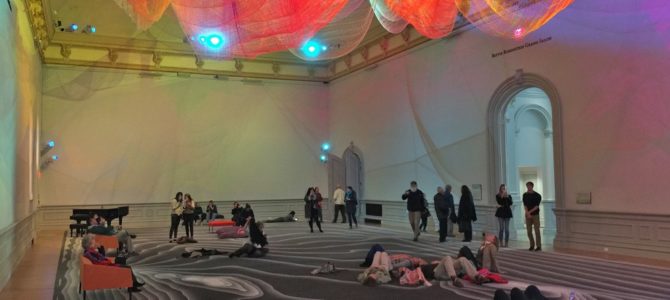
On a gorgeous sunny April day, crowds gathered at the Renwick Gallery, home to exhibits of the Smithsonian’s American Art Museum. The current exhibit, which opened a few weeks ago and consumes the gallery’s entire floor space, focuses on the art of the Burning Man festival held annually in the Nevada desert.
Judging from the throngs in attendance—the line to get into the building snaked all the way across Pennsylvania Avenue—the Renwick has a hit on its hands. It appeared to approach the popularity of the “Wonder” exhibit the Renwick hosted nearly three years ago. Coming as the gallery reopened after a multi-year renovation, that exhibit turned a relatively quiet artistic outpost that tourists stumble upon while walking by the White House into a destination visited by nearly three-quarter million locals and tourists.
Signs around the current Burning Man exhibition hinted at larger forces at play. They echoed the gallery’s website: “We encourage visitors to take photos and post to social media using the hashtags #NoSpectators #RenwickGallery.”
One couldn’t help but notice a hint of irony. As the commentary throughout the exhibit noted, Burning Man provides an opportunity for participants to escape from technology—WiFi, cell phones, and screens of all sorts—during their week in the forbidding desert.
Yet the exhibit actively encourages individuals to contradict the spirit of the event the exhibit celebrates, prodding them to post pictures online to generate social media buzz. Many, if not most, of the visitors over the weekend did just that, snapping pictures, taking videos of the moving displays, and posing for selfies, often while stumbling over other guests doing the exact same things.
Therein lies the art world’s current conundrum: Encouraging individuals to engage with art often involves appealing to their narcissistic instincts. Case in point: The Hirshhorn Gallery’s exhibit of Yayoi Kusawa’s “Infinity Mirrors” last spring. As a Cleveland blog described it, Kusawa’s exhibit continues “the trend of excessively long online wait times to access cultural experiences, which will undoubtedly saturate your social media feeds” once the exhibit opens in Ohio later this summer.
“Infinity Mirrors” helped attract attention for, and dollars to, the Hirshhorn. One membership level grew by 500 percent, largely because people realized that buying membership guaranteed access to an exhibit with more demand than tickets. But to what end?
The exhibition involves a series of mirrored chambers, and guests spend roughly 20-30 seconds in each chamber. When I visited the “Infinity Rooms” exhibit last spring, one of my fellow guests complained—loudly, and repeatedly—to Hirshhorn staff, because I ended up sharing one of the infinity rooms with her.
Mind you, my presence in the infinity chamber did not impede my fellow guest’s ability to appreciate Kusawa’s art, nor she mine. However, because one cannot escape the reflection of another person in a chamber with six mirrored walls, my presence did impede her ability to take photos to post to social media.
In other words, it’s all about the selfie. It isn’t about appreciating art, it’s about the visitor being seen in the presence of the art, basking in its reflected glory rather than using it as a medium to search for, or reflect upon, any higher meaning.
One can make a compelling case for exhibits like “Infinity Mirrors,” “Wonder,” and the Renwick’s Burning Man show. Museums need to bring art to the people, and that art should go beyond unintelligible postmodern paintings hanging in hushed galleries. Using buzzworthy exhibits to engage the broader public, particularly younger generations, in art will lead them to a deeper appreciation over time.
On the other hand, the extent to which these exhibits only further indulge the vanity of an already self-absorbed society should give one pause. At its best, art should prompt thought and emotion, ranging from joy to outrage and everything in between. If instead of reflection art prompts a reflex—to snap the ultimate selfie—what does that say of modern man’s ability to look beyond himself?
The Renwick’s Burning Man exhibit notes that many of the festival’s attendees have come to lament the creeping commercialism associated with the gathering, to the point that “Burning Man Was Better Last Year” has become an annual mantra. Unfortunately, given our current culture, the same might be said of art in general—not because of the people who create it, but the people who use art not to appreciate others but to adorn themselves.









